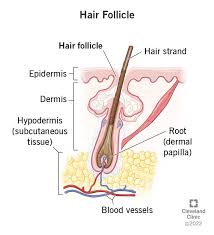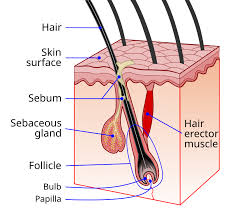
 A skin appendage with multiple functions, important in thermoregulation, solar radiation protection, and sexual dimorphism.
A skin appendage with multiple functions, important in thermoregulation, solar radiation protection, and sexual dimorphism.
The hair unit is composed of specialized compartments that are coordinatedly responsible for synthesis of the hair fiber.
Differences in hair morphology in human populations of different ancestors, are believed to be genetically determined.
The hair morphology in human populations of different ancestries, are believed to be genetically determined.
Hair follicles contain several different types of cells, including melanocyte stem cells that generate cells that produce the pigment melanin responsible for hair color.
These melanocyte stem cells migrate between two sites in the hair follicle during each cycle of hair growth and shedding from a site where they produce the pigment for hair color to another where they produce stem cells.
Aging results in a greater portion of these melanocyte stem cells getting stuck at the site where they produce stem cells, which leaves a smaller portion of stem cells to generate melanin-producing cells, resulting in the graying of hair.
The increase in the number of follicle growth cycles with aging is associated with deficits in melanocyte stem cells.
Stem cells residing in the follicle that can form hair pigment-producing melanocytes.
These deficits are thought to lead to graying of hair.
Melanocyte stem cells are found in two distinct locations at the base of each hair follicle.
In the bulge location of the hair follicle these melanocyte stem cells undergo self-renewal to maintain a population of immature stem cells.
In the hair germ area melanocyte stem cells can differentiate to form melanocytes that produce melanin pigment for hair.
Melanocyte stem cells can migrate back and forth between the two aforementioned locations, differentiating to produce hair pigment-producing melanocytes in the hair germ area and then translocating to the bulge and dedifferentiating to ensure the maintenance of an adequate supply of stem cells.
Melanocyte stem cells can differentiate into a pigment-producing partially differentiated state and then revert back to an undifferentiated state.
The migration of the cells between these regions is disrupted with repeated hair follicle growth cycles, resulting in fewer stem cells that can develop into pigment-producing melanocytes, thus leading to hair graying.
Melanocyte stem cells are more dynamic/mobile than previously thought, and can reversibly alter cell state from immature to mature state, and this reversibility is critical for the proper maintenance of these stem cells.
Maintaining healthy melanocyte stem cells is the key to preserving hair color.
Melanocyte stem cells are mobile but can start the regeneration of hair melanocytes only when they are present in the hair germ compartment.
The melanocyte stem cell localization may be altered during the course of aging.
Each strand of hair consists of the outer visible part called the shaft and the root that lies beneath the surface of the skin.
There are wide variety of cells present in the hair follicle, which include stem cells.
The stem cells in the hair follicle generate the cells to help regenerate hair follicle cells and facilitate hair growth.
During a person’s lifetime, each hair follicle undergoes several growth cycles that consist of three phases.
Hair follicles, the structures that produce hair, undergo several cycles of growth over an individual’s lifetime.
The hair of individuals with African ancestry has a flat and cross-sectional appearance and the hair is usually coiled.
The hair of persons of European ancestry have a oval cross-section, and the hair persons of Asian ancestry has a rounded, more circular perimeter, resulting in straighter hair.
The major signaling center of the hair follicle resides in the dermal papilla.
The dermal papilla consist of a specialize fibroblast population that is responsible for regeneration and cycling of the follicle.
The dermal papilla interacts with overlying epithelial cells, the hair matrix, to generate the hair shaft.
The dermal papilla is dynamic and regulated, and a reduction in the number of cells that make up the dermal papilla contributes to the loss or thinning of hair.
The hair shaft contains complex structural proteins, including many different hair keratin with associated proteins, responsible for formation and growth of the hair shaft.
There are about 50 million hair follicles covering the body with 20% being in the scalp.
The hair follicle is a skin appendage with a primary function to produce the visible hair shaft.
The hair follicle is divided into sections.
The upper sections of the hair follicle are permanent, with the infundibulum running from the opening of the sebaceous gland duct to the site where the hair follicle meets the epidermis, providing a funnel through the epidermis and provides an opening for the hair shaft.
The isthmus at the lower boundary of the sebaceous gland is at the insertion of the arrector pili muscle, and is described as the bulge.
The bulge contains epithelial hair follicle stem cells.
The progeny of the hair follicle stem cells that produce the hair bulb matrix keratinocytes, and contributes to the epidermis.
Hair follicle renewal is maintained by the stem cells associated with each follicle.
Aging of the hair follicle appears to be related to cellular response to the DNA damage that accumulates in renewing stem cells during aging.
The response to DNA damage involves the proteolysis of type XVII collagen by neutrophil elastase.
Proteolysis of collagen leads to elimination of the damaged cells and then to terminal hair follicle miniaturization.
Damage to these cells impairs hair shaft production
Scalp contains an average of 100,000 hairs.
Scalp and facial hair associated with general well-being, social status, sexual attraction.
Hair is often used for social statements and political affiliations.
More than 90% of scalp hairs are growing and are called anagen hairs.
Hair follicle growth occurs in cycles.
Anagen refers to the growth phase that can last between two to six years and involves the division of cells in the hair follicle, leading to the elongation of the hair shaft.
The growth phase is followed by a short transitional phase, catagen, that lasts a few weeks and involves shrinkage of the hair follicle and slowing of hair growth.
The subsequent phase is called the resting phase or telogen, which lasts three to four months and involves the cessation of growth and shedding of old hair, followed by the initiation of a new growth phase.
Cells that compose the hair follicle and produce keratin are generated by hair follicle stem cells.
In contrast, the melanocytes that produce melanin, the pigment responsible for hair color, are generated by the differentiation of melanocyte stem cells.
These mesechymal stem cells (MSCs) are present at two distinct locations during the telogen phase.
This includes McSCs present in a transitory structure called the hair germ area.
The hair germ area also contains hair follicle stem cells and plays an important role in hair elongation during the growth phase.
Above the hair germ area of the hair follicle lies a region called the bulge, which also contains McSCs.
The bulge area is known as the stem cell compartment and is thought to be necessary for maintaining a reserve stem cell population.
While the bulge area potentially serves as the stem cell compartment, the melanocyte stem cells in the hair germ area differentiate to form mature melanocytes that produce pigment for hair during the growth or anagen phase.
McSCs travel between these sites and have the ability to perform the functions of both self-renewal and producing differentiated, mature melanocytes.
Melanocyte stem cells, can dedifferentiate.
The protein Wnt expressed by epithelial cells in the bulb activated the Wnt signaling pathway in hair germ McSCs, causing them to differentiate.
These results suggest that the Wnt pathway plays an important role in the regulation of the differentiation and dedifferentiation of the McSCs.
A more rapid age-associated decline in the regenerative capacity of McSCs than that observed in follicle stem cells.
The follicle stem cells continue to produce cells that facilitate hair elongation but in the absence of adequate pigment-producing melanocytes, results in graying of hair with aging.
It is thought that McSCs in the bulge mostly contribute to the maintenance of the stem cell population through self-renewal and do not produce differentiated pigment-producing melanocytes: the accumulation of hair germ McSCs in the bulge with aging may lead to a lower proportion of stem cells returning to the hair germ area, where they could produce the melanin pigment for hair.
It is perfectly normal for people to shed between 50 and 100 hairs from their heads every day.
Possible causes of hair loss include:
major stressors, such as a prolonged illness, job loss, or a bereavement (telogen effluvium)
some medications, including antidepressants, beta-blockers, levodopa, and chemotherapy drugs
illnesses such as thyroid disorders, a sex hormone imbalance, or a dietary deficiency of protein, iron, zinc, or biotin.
autoimmunity, which can cause hair to fall out in one or more small patches on the scalp, eyebrows, or eyelashes-alopecia areata
tight hairstyles that strain the hair follicles, known as traumatic or traction alopecia
a combination of genetics, male hormones, and increasing age, known as pattern hair loss or androgenetic alopecia; this can affect both males and females.
A hair follicle is a tube-like skin pore that encloses the shaft and root of the hair.
Most healthy adults have around 80,000–120,000 hairs on their scalps.
Each hair follicle repeatedly undergoes a growth cycle that comprises three distinct phases: anagen, catagen, and telogen.
During anagen, which lasts between 2 and 7 years, the hair within the follicle grows about 1 centimeter per month.
The follicle then enters catagen, a 2-week transitional phase during which the hair detaches from the blood supply.
During the final, inactive stage, or telogen, the follicle sheds the hair.
It can then take up to 4 months before the follicle starts to grow a new one.
Two to 3 months after a person experiences a traumatic or stressful event they can develop telogen effluvium— a type of hair loss in which the follicles remain stuck in the inactive, hair-shedding stage.
The hair follicle is one of the few tissues in the body that can regenerate itself by adult stem cells.
It is suspected that high steroid levels during stress inhibits stem cells activity.
The dermal sheath muscle that surrounds each hair follicle may play a role in hair loss and regeneration.
Each cycle consists of a long growing phase, anagen, a short transitional phase, catagen, and a short resting phase telogen.
At the end of the resting phase, the hair falls out, xogen, and a new hair starts growing in the follicle beginning the cycle again.
Anagen hair are deeply rooted in subcutaneous fat tissue.
Scalp hair constantly regenerating on the scalp.
Anagen phase of hair growth lasts for most of the 3-7 years and is followed by a 2 week catagen phase.
Catagen phase associated with apoptosis, after which hair goes into the telogen phase, a resting phase, that lasts 3 months.
Telogen hair is more superficially located than anagen hair and is easily pulled out resulting in scalp losses of approximately 100 telogen hairs per day.
Normally, about 40 hairs reach the end of their resting phase each day and fall out.
Scalp hair shafts last 3-7 years and subsequently fall out and are replaced by a new hairs.
Only areas free of hair follicles are the lips, soles and palms.
Before puberty hair is small, straight, and fair termed vellus.
At puberty, with increased levels of androgens, vellus follicles in specific areas develop into terminal hairs which are larger, curlier, darker and more visible becoming sexual hair follicles.
Higher androgen levels are required for the beard development than for the growth of pubic and axillary hair.
The scalp hair follicle in Caucasians is elliptical in shape and, therefore, produces straight or wavy hair, whereas the scalp hair follicle of people of African descent is more curvy, resulting in the growth of tightly curled hair.
